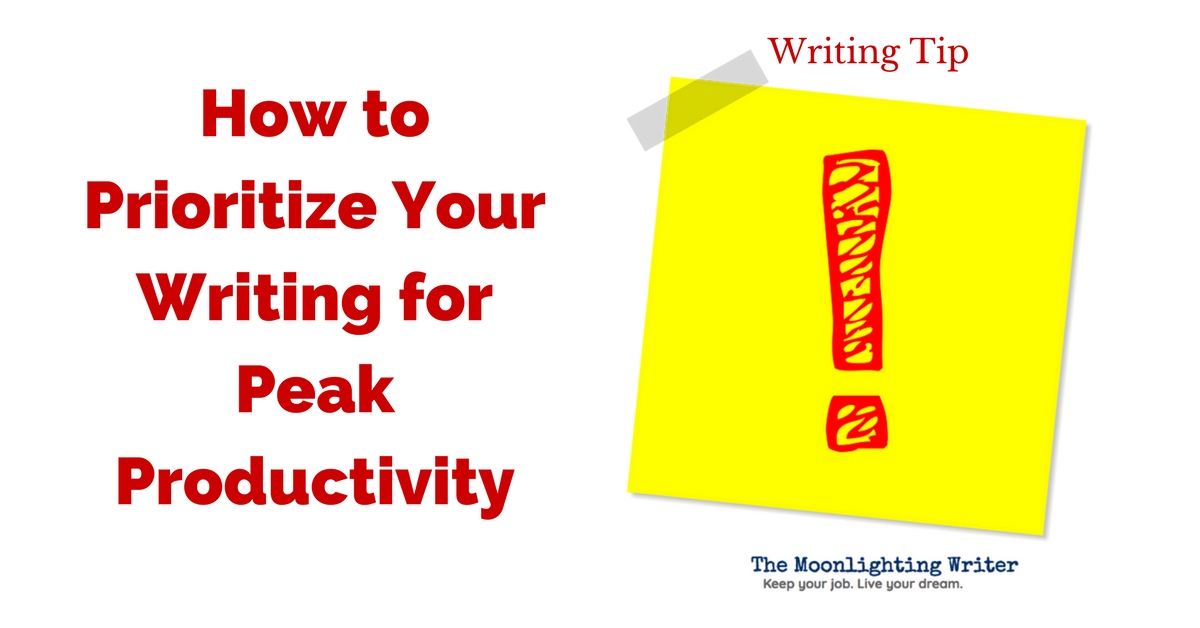[et_pb_section admin_label=”section”][et_pb_row admin_label=”row”][et_pb_column type=”4_4″][et_pb_text admin_label=”Text”]
Even if you successfully break down your goals into bite-sized chunks — such as daily goals and mini-milestones — there is still a danger of not achieving your goals.
The problem is that we all have a stack of competing tasks and, even when we work in manageable fragments, we can get distracted by the avalanche of demands on our time. If you’re working on a novel and a blog and a short story all during the same period, how do you know which one you should work on at any given time?
The answer is that you have to prioritize your writing tasks.
How to Prioritize Your Writing Projects
First off, you need to prioritize your writing — as a general concept in your life. That’s why setting deadlines and scheduling your writing are so crucial to success. They force you to value your writing right along with all the other important parts of your world.
For this discussion, let’s assume you’ve already taken care of that part.
Now, what we want to do here is prioritize your writing activities against each other.
Here’s how to go about it:
Line up all your projects where you can see them. You can use post-it notes, index cards, or a spreadsheet, but one of my favorite tools for prioritization is Trello.
For each project on your list, figure out:
- How important is it to your overall goals as an author?
- How long will it take you to complete the project?
- When is the optimal time to complete the project?
- How will the project move you toward your goals? Will it make money? Generate traffic?
- How bad would you feel if you don’t ever complete the project? Would it really matter?
After you answer these questions, use them as a score and rank your projects against each other. Order them from highest priority — all things considered — to lowest priority.
How to Prioritize Your Writing Tasks
Now that you have your list of projects in order, you need to determine how you’ll go about doing the actual work to finish your projects.
Prioritization will help you out here, too. This time, though, you’ll be ranking the smaller, session-by-session tasks that will take you from first blank page to finished novel (or whatever your goals is).
Here’s how:
Start with the project on top of your priorities list.
- If you haven’t done so already, break down that project into a series of tasks, each of which is bite-sized in some way. Some divisions you might consider:
- Chapters for a novel or how-to book
- Individual blog posts for a new website
- Bullet points from your project outline
- Any other unit of work you can complete in one or two sittings
- For each item in the task list developed above, ask these questions:
- How risky is it to my project if I don’t finish this task?
- How risky is it to my project if I don’t finish this task?
- How long will it take to finish this task?
- Am I sure this task can’t be broken up further? (If yes, chunk it up and start the task-level prioritization over from the top.)
- When do I need to finish this task in order to complete my project on time?
- Armed with these “scores,” rank the tasks from highest priority to lowest priority.
- Repeat these steps for the next project on your overall priorities list.
Depending on how closely your projects rank to each other in terms of overall priorities, I would recommend having task-level priorities available for 2-4 projects at a time. That way, you always know what you should be doing at any given writing session.
How to Use Your Priorities
So there you have it: a list of task-level priorities to drive your writing efforts for the foreseeable future.
Your destiny is set, for better or for worse.
OK, maybe it’s not quite that dire.
In reality, you should maintain some flexibility in your schedule or you risk burnout. No one is a robot who can just chug through the same list day after day.
So how should you use your priorities list? As usual — in this post, at least — I have some bullet points:
- Open your prioritized list of writing tasks.
- Open your weekly writing schedule.
- Start at the top of your priorities list and match that task to the first time slot that fits the anticipated completion time for the task. Schedule it.
- Alternatively, schedule the task across multiple time slots if it won’t fit in one.
- Move on to the second task and the third and so on.
- Schedule out your work for the next week or two.
You’ll run into situations where none of the work in your top project that fits any available time slots. In those cases, you can move to your second project and start plucking priorities from there.
And, once you knock out a few of your top priorities from your top project, you may decide that your second-level project needs some love.
When that happens, you’re all set, because, once again, all you have to do is start at the top of Project 2 and slot those high-priority tasks as soon as you can.
Not only does prioritization help ensure you stay on track with your writing goals, it also gives you the freedom to be flexible with your work, and to flex with confidence.
How do you prioritize your writing? Tell me about it in the comments below.
[/et_pb_text][et_pb_text admin_label=”Butt-In Seat Inline Opt-In” background_layout=”light” text_orientation=”left” use_border_color=”off” border_color=”#ffffff” border_style=”solid” saved_tabs=”all”] [et_bloom_inline optin_id=”optin_12″] [/et_pb_text][/et_pb_column][/et_pb_row][/et_pb_section]
